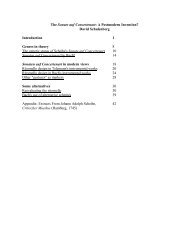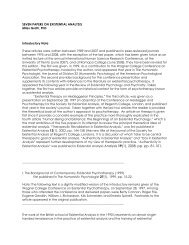download
download
download
You also want an ePaper? Increase the reach of your titles
YUMPU automatically turns print PDFs into web optimized ePapers that Google loves.
4<br />
W. 4: Sources, p. 2<br />
4 original. The doublings also include ornament signs not found in the string parts, suggesting that<br />
5<br />
the keyboard part was intended to serve as an arrangement playable without strings. Besides<br />
these ornaments the source also contains the additional “alternate” performance markings<br />
described below.<br />
A2: D B Mus. ms. Bach St 498<br />
Six manuscript parts in three (?) hands<br />
The parts are as follows:<br />
“Cembalo” in the hand of J. H. Grave: 18 pages, the last blank (33.5 x 22 cm). Watermarks:<br />
(a) large fleur-de-lys and “J KOOL”, (b) “VI”;<br />
“Violino Primo”, “Violino Secondo”, “Viola”, and “Basso Ripieno”: each four pages<br />
(Auflagebogen, 32.5 x 20.8 cm). Watermarks: (a) large crowned medallion, lion holding<br />
staff (scepter?) and arrows, (b) smaller medallion beneath crown, “CR”<br />
“Violono”: four pages (33.7 x 20.2 cm), slightly yellower paper. Watermarks: (a) large lion<br />
rampant over “A G [C?] A . . . V [W?] A”, (b) crown over “M N”. 6<br />
There is no title page or wrapper. The hand of the Violono part is very similar to that of the<br />
keyboard, which is by Grave, and might be his own copy made at a later date, presumably to add<br />
7<br />
an additional bass instrument to the ensemble. Each part bears the title “Concerto” at the<br />
beginning of the first system.<br />
Johann Heinrich Grave (1750?–1810) is identified as “Herr Advocat Grave” of Greifswald in<br />
lists of subscribers for Bach's publications beginning with W. 57 of 1781. Two letters to him<br />
from Bach are known through copies by Zelter. The earlier letter, dated 28 April 1784, is<br />
8<br />
addressed “Best Friend” (“Beßter Freund”) and seems unusually personal in tone. Bach<br />
describes the concerto W. 31 as “one of my show pieces” and mentions a “trio,” presumably a<br />
work for keyboard and violin, in which he was “inimitably accompanied at court” by Franz<br />
In i.22 the first four notes bear both dots and a slur; in other sources of W. 4 this type of notation is<br />
restructed to repeated notes. Perhaps in an earlier copy, note 1 had borne a dot or stroke intended to distinguish it<br />
from the slurred notes that follow, but through misunderstanding both dots and slur were extended to cover all four<br />
notes.<br />
5<br />
E.g., at i.6, app. (b�, 8th, with slur) prior to note 1 (= early version); i.12, app. (c��, 8th, with slur) prior to<br />
note 1; i.14, Anschlag (d��–f���, 16ths) prior to note 1.<br />
6<br />
Mary Oleskiewicz provided a detailed physical description of A2, including watermarks.<br />
7<br />
Enßlin, 680, traces several watermarks of the “KOOL” type to the Dutch paper maker Jan Kool (d. 1816).<br />
The latter acquired the paper mill known as De Bonsem at Koog aan de Zaan in 1774. Unfortunately this is<br />
insufficient to provide a precise time frame for the preparation of the five main parts of A2, and the watermark for<br />
the “Violono” part could not be observed clearly enough to provide a positive identification.<br />
8<br />
Bach wrote to J. J. H. Westphal in similar terms in a letter of 25 September 1787, describing “3 Stück von<br />
meinen ehemaligen Paradeurs”; see Leisinger / Wollny 1997, 44fn. 63.















